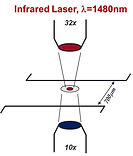Physical Biology Laboratory
Department of Physics and Astronomy - University of Pittsburgh
Bacterial Thermotaxis
Microorganisms often have to navigate through their surroundings in search of nutrients and a better environment for survival. One of the important environmental cues microorganisms follow is temperature. Bacteria sense temperature differences and follow thermal gradients towards their favorable temperature which could help bacteria colonize certain regions, form biofilms, and infect host cells or tissues.
Temperature however (unlike chemicals), cannot be treated as an external signal that microorganisms sense through specific receptors only. Temperature is known to affect all biochemical activities in living cells, as well as, the structure, function, and binding affinity of all proteins. It also affects the environment by changing the viscosity and pH. Therefore, when studying thermotaxis it is not sufficient to focus on the response of the signal transduction network alone. One has to also take into consideration how temperature affects other factors in the cell that can influence its behavior, such as its migration speed. In addition, since thermal signals are often processed through the same pathway as chemicals such as in bacteria, it is important to understand how the chemical environment affects the cell’s response to thermal changes (Demir et al 2011).
Our research aims to understand how bacteria navigate in temperature gradients and how they localize themselves at their favored temperature, as well as, quantitatively describe their behavior in such environments. We focus primarily on two parts of the thermotaxis system in bacteria, the output channel represented by the flagellar motor (Demir et al 2012), and the input channel consisting of the two most abundant sensing receptors Tar and Tsr (Salman et al 2007). This we hope, will help in developing biological networks for precision sensing and will facilitate better control of their accuracy. It will also help better understand how temperature affects microorganisms and their response to thermal fluctuations and to identify the limitations of biological systems in such environments.
The effect of Tar/Tsr ratio on the response of the bacteria to a temperature gradient


Temperature gradient is applied by focusing an infrared laser into the sample. When the ratio Tar/Tsr is larger than a critical value the bacteria escape from heat. For ratios of Tar/Tsr less than the critical value, the temperature of preference changes with the ratio.